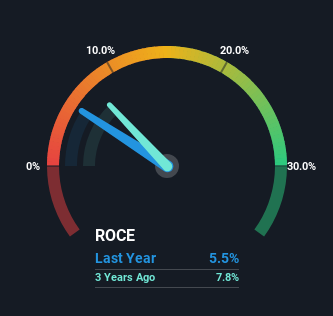- Hong Kong
- /
- Water Utilities
- /
- SEHK:6136
Kangda International Environmental's (HKG:6136) Returns On Capital Not Reflecting Well On The Business
What are the early trends we should look for to identify a stock that could multiply in value over the long term? Typically, we'll want to notice a trend of growing return on capital employed (ROCE) and alongside that, an expanding base of capital employed. If you see this, it typically means it's a company with a great business model and plenty of profitable reinvestment opportunities. Having said that, from a first glance at Kangda International Environmental (HKG:6136) we aren't jumping out of our chairs at how returns are trending, but let's have a deeper look.
What Is Return On Capital Employed (ROCE)?
For those who don't know, ROCE is a measure of a company's yearly pre-tax profit (its return), relative to the capital employed in the business. The formula for this calculation on Kangda International Environmental is:
Return on Capital Employed = Earnings Before Interest and Tax (EBIT) ÷ (Total Assets - Current Liabilities)
0.055 = CN¥750m ÷ (CN¥19b - CN¥5.4b) (Based on the trailing twelve months to June 2023).
Thus, Kangda International Environmental has an ROCE of 5.5%. On its own, that's a low figure but it's around the 6.0% average generated by the Water Utilities industry.
See our latest analysis for Kangda International Environmental

While the past is not representative of the future, it can be helpful to know how a company has performed historically, which is why we have this chart above. If you want to delve into the historical earnings , check out these free graphs detailing revenue and cash flow performance of Kangda International Environmental.
What Can We Tell From Kangda International Environmental's ROCE Trend?
On the surface, the trend of ROCE at Kangda International Environmental doesn't inspire confidence. Around five years ago the returns on capital were 7.5%, but since then they've fallen to 5.5%. Given the business is employing more capital while revenue has slipped, this is a bit concerning. This could mean that the business is losing its competitive advantage or market share, because while more money is being put into ventures, it's actually producing a lower return - "less bang for their buck" per se.
Our Take On Kangda International Environmental's ROCE
From the above analysis, we find it rather worrisome that returns on capital and sales for Kangda International Environmental have fallen, meanwhile the business is employing more capital than it was five years ago. This could explain why the stock has sunk a total of 79% in the last five years. That being the case, unless the underlying trends revert to a more positive trajectory, we'd consider looking elsewhere.
One more thing: We've identified 4 warning signs with Kangda International Environmental (at least 2 which are concerning) , and understanding these would certainly be useful.
For those who like to invest in solid companies, check out this free list of companies with solid balance sheets and high returns on equity.
Valuation is complex, but we're here to simplify it.
Discover if Kangda International Environmental might be undervalued or overvalued with our detailed analysis, featuring fair value estimates, potential risks, dividends, insider trades, and its financial condition.
Access Free AnalysisHave feedback on this article? Concerned about the content? Get in touch with us directly. Alternatively, email editorial-team (at) simplywallst.com.
This article by Simply Wall St is general in nature. We provide commentary based on historical data and analyst forecasts only using an unbiased methodology and our articles are not intended to be financial advice. It does not constitute a recommendation to buy or sell any stock, and does not take account of your objectives, or your financial situation. We aim to bring you long-term focused analysis driven by fundamental data. Note that our analysis may not factor in the latest price-sensitive company announcements or qualitative material. Simply Wall St has no position in any stocks mentioned.
About SEHK:6136
Kangda International Environmental
An investment holding company, engages in the urban water treatment, water environment comprehensive remediation, and rural water improvement businesses in Mainland China.
Good value with proven track record.
Market Insights
Community Narratives


Recently Updated Narratives


MINISO's fair value is projected at 26.69 with an anticipated PE ratio shift of 20x


The Quiet Giant That Became AI’s Power Grid


Nova Ljubljanska Banka d.d will expect a 11.2% revenue boost driving future growth
Popular Narratives


The company that turned a verb into a global necessity and basically runs the modern internet, digital ads, smartphones, maps, and AI.


MicroVision will explode future revenue by 380.37% with a vision towards success



